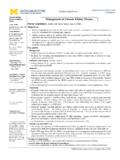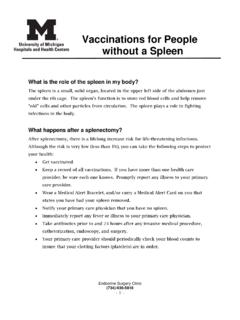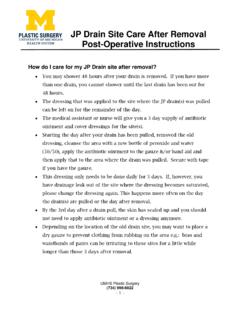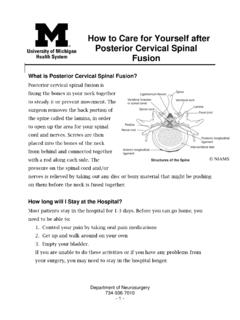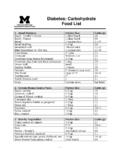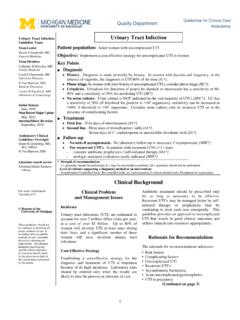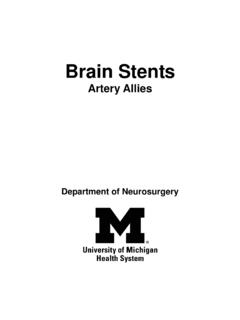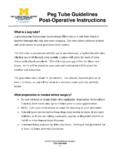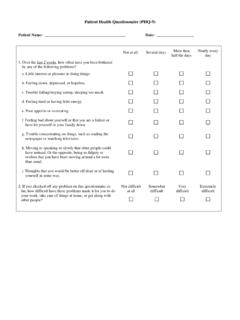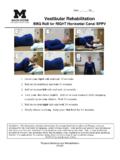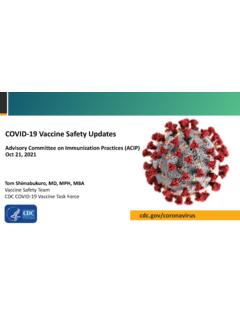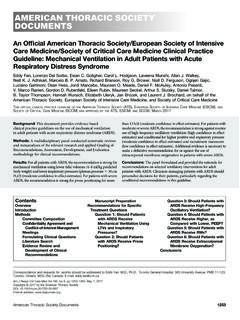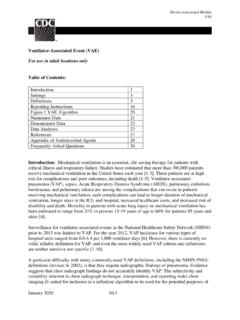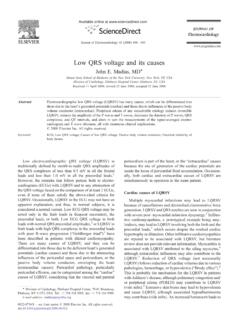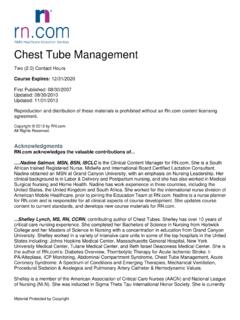Transcription of OUTPATIENT GUIDANCE FOR TREATMENT OF COVID-19 …
1 OUTPATIENT GUIDANCE FOR TREATMENT OF COVID-19 IN ADULTS AND CHILDREN These are interim TREATMENT recommendations based on best available evidence at this time. Recommendations may be modified based on resource availability, testing recommendations, and future published data. Clinical symptoms range from uncomplicated upper respiratory tract viral infection to pneumonia, acute respiratory distress syndrome (ARDS), sepsis, and septic shock. Testing: See link to current COVID-19 testing recommendations: Send testing for COVID-19 Prevention: See link to institutional Evusheld (tixagevimab-cilgavimab) criteria TREATMENT : Please see detailed prescribing recommendations in the covid OUTPATIENT TREATMENT guidelines and the State eligibility criteria for Paxlovid and molnupiravir Further, please factor symptom duration and relevant drug-drug interactions with Paxlovid into TREATMENT decisions.
2 Paxlovid (oral) molnupiravir (oral) bebtelovimab (IV) Patient demographics age 12, 40 kg age 18 age 12, 40 kg Symptom onset range (to start therapy within) Sx 5 days1 Sx 5 days1 Sx 7 days1 Relative risk reduction in hospitalization or death 88% 30% 85% Criteria Mild-moderate covid in a patient at high risk for progression to severe covid -192 Alternative ONLY if patient cannot get Paxlovid nor mAb Regardless of vaccination status with one of the following: Severe3 immunocompromise Absolute drug contraindication to Paxlovid AND moderate4 immunocompromise Not up-to-date5 on vaccines with one of the following: Pregnant Absolute drug contraindication to Paxlovid AND additional CDC risk factor for severe disease3 Notes Evaluate for DDI Not for use in pregnancy Preferred in pregnancy and severe immunocompromise4 *Otherwise, only if Paxlovid is contraindicated, or if not available 1 First day of symptoms counts as day 0 ( , if symptoms started on Monday (day 0), Saturday would be day 5) 2 CDC risk factors include (not all inclusive): Age 65 years, immunosuppression, chronic lung disease, chronic kidney disease, chronic liver disease, neurological conditions, diabetes, down syndrome , heart conditions, mental health conditions, BMI 25, sickle cell disease or thalassemia, smoking, cerebrovascular disease, substance use disorders, tuberculosis 3severe immunocompromise.
3 Solid organ transplant, bone marrow transplant, hematologic malignancy, on b-cell depleting therapy ( , on rituximab) 4moderate immunocompromise: Primary immunodeficiency, active malignancy and receiving chemotherapy, autoimmune diseases requiring immunosuppressive therapy (hydroxychloroquine or sulfasalazine alone is not sufficient), advanced or untreated HIV infection 5up-to-date w/vaccines = a person has received all recommended COVID-19 vaccines, including any booster dose(s) when eligible (5 months after primary series) Supportive Care Monoclonal Antibody Oral Antiviral (Paxlovid) (Molnupiravir) Inhaled Corticosteroids Page 2 of 7 Paxlovid and monoclonal antibody therapy are equally efficacious (88% vs. 85% risk reduction of hospitalization or death due to COVID-19 ). Paxlovid is the preferred therapeutic agent if the patient can obtain and start the medication in a timely manner ( 5 days of symptom onset), unless the patient is severely immunocompromised or pregnant.
4 Monoclonal antibody is an appropriate alternative for those who cannot receive Paxlovid (due to drug availability, timing of symptoms, or contraindications). Molnupiravir is inferior to both Paxlovid and monoclonal antibody (30% risk reduction) and should only be used if both Paxlovid and monoclonal antibody therapy are unavailable. 1. Supportive care: Supportive care is the mainstay of TREATMENT for non-hospitalized patients. 2. Monoclonal antibody infusion: The FDA has issued an EUA for bebtelovimab for non-hospitalized adults and adolescents (12-17 years old) with mild to moderate symptoms (not requiring oxygen supplementation) of COVID-19 with risk factors for progression to severe disease (see Michigan Medicine Eligibility Criteria). Monoclonal antibody therapy for covid have been developed to bind to the spike protein of SARS-CoV-2 and block the virus from invading human cells.
5 Research suggests that it may reduce the chances that high-risk patients with mild to moderate COVID-19 will develop severe disease that requires a visit to the emergency department and/or hospitalization. The goal is to give the medication as early in the course of disease as possible. The criteria utilized to identify patients with risk factors for severe disease have been approved by the Scarce Resource Allocation Committee and will be re-evaluated based on drug supply and infusion capacity. A clinician must place a Referral for COVID-19 Monoclonal Antibody TREATMENT order, which will go directly to the covid mAb trained pharmacy team. If a patient is potentially eligible and capacity allows, the patient will be contacted to discuss symptom duration and consent and proceed with scheduling the infusion based on capacity available. Due to the limited supply, not all patients referred will be able to be treated.
6 Patients can also be referred to the MDHHS covid Therapeutics webpage to seek out other sites for possible TREATMENT . Patients will receive the medication IV as 30 second to 30-minute infusion, depending on product available. One hour of observation afterwards is required. Rarely, patients could experience an allergic reaction or an infusion-related reaction during the infusion (~1% in the COMET-ICE study). Table 1. Michigan Medicine Monoclonal Antibody Eligibility Criteria A patient must have had a Michigan Medicine encounter in the last 5 years OR be a Michigan Medicine employee OR be a University of Michigan student OR be a resident of Washtenaw County Priority group: Patients who are pregnant, have severe immunocompromise3, and/or have absolute drug contraindications will be prioritized. Other patients in this group should be prescribed Paxlovid if it is available.
7 Patients with mild or moderate COVID-19 who meet criteria #1-4 AND either criteria #5 OR criteria #6: 1. OUTPATIENT 2. No requirement for supplemental oxygen (or no increase from baseline supplemental oxygen) 3. Symptoms 7 days 4. Not received Paxlovid 5. Age 12 years and 40 kg (regardless of vaccination status) AND one of the following: a) Severe immunocompromise3 b) Moderate4 immunocompromise AND an absolute drug contraindication to Paxlovid 6. Not up-to-date w/vaccines5 AND one of the following: a) Pregnancy b) CDC risk factor for severe disease2 AND absolute drug contraindication to Paxlovid 2 CDC risk factors include (not all inclusive): Age 65 years, immunosuppression, chronic lung disease, chronic kidney disease, chronic liver disease, neurological conditions, diabetes, down syndrome , heart conditions, mental health conditions, BMI 25, sickle cell disease or thalassemia, smoking, cerebrovascular disease, substance use disorders, tuberculosis 3severe immunocompromise: solid organ transplant, bone marrow transplant, hematologic malignancy, on b-cell depleting therapy ( , on rituximab) 4moderate immunocompromise.
8 Primary immunodeficiency, active malignancy and receiving chemotherapy, autoimmune diseases requiring immunosuppressive therapy (hydroxychloroquine or sulfasalazine alone is not sufficient), advanced or untreated HIV infection 5up-to-date w/vaccines = a person has received all recommended COVID-19 vaccines, including any booster dose(s) when eligible (5 months after primary series) Page 3 of 7 3. Oral antivirals The FDA issued Emergency Use Authorization (EUA) for two novel antiviral agents, ritonavir-boosted nirmatrelvir (Paxlovid) and molnupiravir, for the TREATMENT of non-hospitalized adults with mild-to-moderate COVID-19 who are at high risk of progression to severe disease. Key information regarding these therapies is provided below; the full FDA Fact Sheets (molnupiravir) (ritonavir-boosted nirmatrelvir) should be referred to for more details. Currently only Meijer (and some other select community) Pharmacies will be receiving supply of both antivirals.
9 MM pharmacy will not be receiving supply. Paxlovid (nirmatreliver tablet and ritonavir tablets), manufactured by Pfizer, for COVID-19 TREATMENT Table 2. State of Michigan Eligibility Criteria for Paxlovid Patients with mild or moderate COVID-19 who meet criteria #1-9 1. Age 12 years and 40 kg 2. OUTPATIENT 3. No requirement for supplemental oxygen (or no increase from baseline supplemental oxygen) 4. Symptoms 5 days 5. Not received bebtelovimab or molnupiravir 6. EGFR 30 mL/min (see section on Paxlovid dosing) 7. Not have severe liver disease (Child-Pugh Class C) 8. No drug-drug interaction that are absolute contraindications (see Paxlovid Drug-Drug Interaction Summary) 9. At high risk for progression to severe disease1 1 CDC risk factors include (not all inclusive): Age 65 years, immunosuppression, chronic lung disease, chronic kidney disease, chronic liver disease, neurological conditions, diabetes, down syndrome , heart conditions, mental health conditions, BMI 25, sickle cell disease or thalassemia, smoking, cerebrovascular disease, substance use disorders, tuberculosis Paxlovid Dosing Standard dose is nirmatrelvir 300 mg (two 150 mg tablets) and ritonavir 100 mg (one 100 mg tablet) orally, with all three tablets taken together, twice daily for 5 days.
10 EGFR 30-59 mL/min, the dose is 150 mg nirmatrelvir (one 150 mg tablet) with 100 mg ritonavir (one 100 mg tablet), with both tablets taken together twice daily for 5 days. Paxlovid is not recommended for patients with severe renal impairment (eGFR <30 mL/min) or severe hepatic impairment (Child-Pugh Class C). Paxlovid Drug Interaction Information Prior to starting a patient on Paxlovid, clinicians must carefully review concomitant medications, including over the counter and herbal products. If absolute contraindications, then refer for monoclonal antibody therapy. Paxlovid has significant drug-drug interactions (DDIs). o Nirmatrelvir is a substrate of CYP3A, so concomitant administration of strong inducers ( , rifampin) may lead to substantial decreases in Paxlovid concentrations, potentially reducing effectiveness. o Nirmatrelvir is co-formulated with ritonavir.
